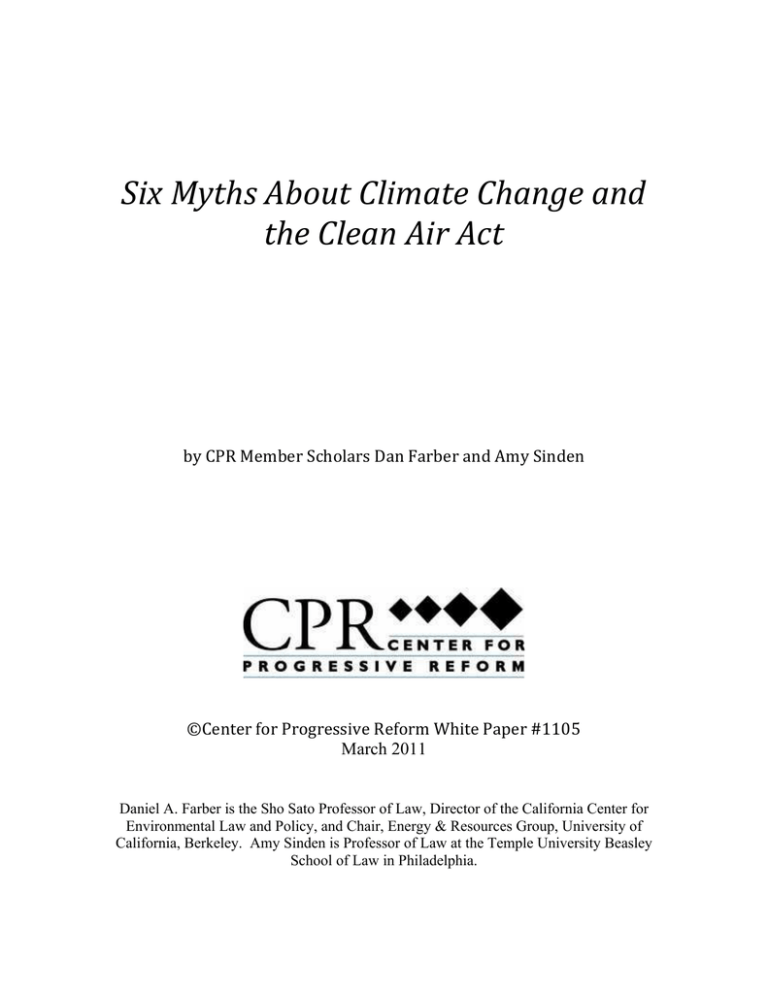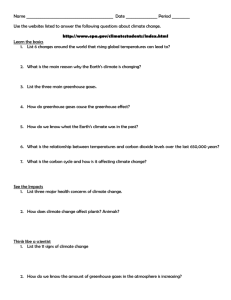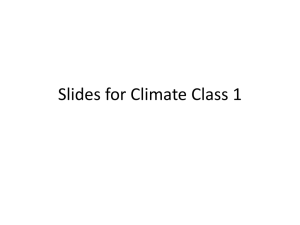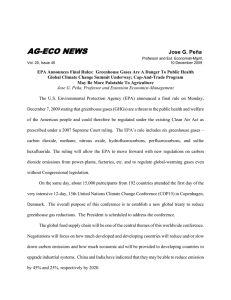Document 11499429
advertisement

Six Myths About Climate Change and the Clean Air Act by CPR Member Scholars Dan Farber and Amy Sinden ©Center for Progressive Reform White Paper #1105 March 2011 Daniel A. Farber is the Sho Sato Professor of Law, Director of the California Center for Environmental Law and Policy, and Chair, Energy & Resources Group, University of California, Berkeley. Amy Sinden is Professor of Law at the Temple University Beasley School of Law in Philadelphia. Six Myths About Climate Change and the Clean Air Act Introduction In the aftermath of the failure of comprehensive climate change legislation in the 111th Congress, opponents of the legislation and some others maintain that the Clean Air Act is somehow an inappropriate tool to address greenhouse gas (GHG) emissions, and that EPA should be prohibited from regulating. It is true that the Clean Air Act was not specifically tailored to the task of curbing GHGs, and that it would undoubtedly be desirable for Congress to pass vigorous legislation that would write a comprehensive climate change framework into law. But it is simply not the case that the Clean Air Act is, in any way, “inappropriate.” As the Supreme Court affirmed in its landmark ruling in Massachusetts vs. EPA, the Clean Air Act plainly anticipated air pollution hazards that were not at the time known to the drafters of the legislation, and provided EPA with tools to reduce the emission of such pollutants. Six commonly asserted misconceptions about the Clean Air Act have fed the confusion: Myth #1: The EPA has made a power grab by trying to use the Clean Air Act. Not true. The Bush EPA actually resisted regulating greenhouse gases under the Clean Air Act for many years. But in 2007, the Supreme Court reversed the agency in Massachusetts v. EPA.1 The statute says that EPA must regulate any air pollutant that may reasonably be anticipated to endanger the public health or welfare and defines “air pollutant” very broadly.2 The Supreme Court held that greenhouse gases are “air pollutants” under the Act. The Court ordered EPA to make a scientific judgment under Section 202 about whether the greenhouse gases emitted by cars and trucks “may reasonably be anticipated to endanger public health or welfare.”3 Making repeated reference to reports from the National Research Council and the Intergovernmental Panel on Climate Change finding conclusive evidence of human-caused global warming, the Supreme Court made clear that, in light of the scientific evidence, it would be difficult for EPA to find no endangerment. Following the Supreme Court’s opinion, even President Bush’s EPA administrator, Stephen Johnson, tried to take stepts to regulate greenhouse gases under the Clean Air Act. Johnson told the President in a letter that the Supreme Court’s decision “combined with the latest science of climate change requires the Agency to propose a positive endangerment finding, as was agreed to at the cabinet-level meeting in November.”4 Indeed, Johnson’s EPA even drafted an endangerment finding, but when the White House refused to open the email containing it, the finding went into legal limbo. Bush’s EPA 1 549 U.S. 497 (2007). 42 U.S.C. §§7521(a), 7602(g). 3 42 U.S.C. §7521(a). 4 Letter from EPA Administrator Stephen L. Johnson to President Bush (Jan. 2008). 2 1 later issued an Advance Notice of Proposed Rulemaking, seeking public comment on how the agency should go about regulating greenhouse gases under the Act, but never actually got to the point of issuing regulations.5 Accordingly, when President Obama came into office in 2009, the EPA had already been procrastinating in response to the Supreme Court’s decision for nearly two years. Given the Supreme Court’s holding, however, the Obama EPA had no choice but to begin moving forward, first by making the positive endangerment finding that Stephen Johnson had said was “required,” and then by fulfilling its mandatory statutory obligation to regulate greenhouse gas emissions, first from cars and trucks, and subsequently from power plants and other large stationary sources. Myth #2: The Clean Air Act was never intended to address a problem like global warming. It’s only aimed at harms from breathing air pollutants. Not true. The Clean Air Act stands for the very broad and uncontroversial principle that we as a society should endeavor to keep air pollution below levels that can cause risks to public health or welfare. Over the years, that language has been read to encompass a whole range of problems that arise from emitting various substances into the air and that go way beyond harms caused by inhaling air pollutants. Thus, the Clean Air Act protects against the poisoning of lakes and rivers from acid rain, the decaying of historic buildings caused by air pollution, the poisoning of children from lead dust on the ground, and the impairment of fetal development when pregnant women eat fish contaminated with mercury that has settled into lakes, rivers and oceans from the air. Congress may not have been specifically thinking about global warming when it passed the Clean Air Act, but it was well aware that scientific advances would uncover new problems in the future. Accordingly, it purposely drafted the language very broadly to encompass any kind of emission of substances into the air that could be anticipated to endanger the public health and welfare. In the words of the Supreme Court: While the Congresses that drafted [the Clean Air Act] might not have appreciated the possibility that burning fossil fuels could lead to global warming, they did understand that without regulatory flexibility, changing circumstances and scientific developments would soon render the . . . Act obsolete. The broad language of [the statute] reflects an intentional effort to confer the flexibility necessary to forestall such obsolescence.6 It is common for Congress and state legislatures to pass statutes with the intent and expectation that they will remain in effect for a long time and come to encompass situations that the drafters never envisioned. Indeed, the legal reporters are full of cases of statutes being “applied in situations not expressly anticipated by Congress.”7 In 1964, 5 Regulating Greenhouse Gases Under The Clean Air Act, 73 Fed. Reg. 44354 (Jul. 30, 2008). Massachusetts v. EPA, 549 U.S. 497, 532 (2007). 7 Pennsylvania Dep’t of Corrections v. Yeskey, 524 U.S. 206, 212 (1998)(Scalia, J.)(holding that the Americans with Disabilities Act applies to inmates in state prisons). 6 2 for example, when the Civil Rights Act was passed, Congress undoubtedly gave absolutely no thought to the problem of sexual harassment. No one had even heard of the term. Now, nearly five decades later, however, few would question the propriety of applying the Civil Rights Act to such claims. The Patent Act was originally passed more than 200 years ago, but the courts have repeatedly construed its language to encompass all kinds of all kinds of technologies—from genetic engineering to computer software— that its drafters could never have even begun to imagine.8 Myth #3: The Clean Air Act only addresses localized pollution problems. Not true. The Clean Air Act contains specific provisions directed at both interstate and international pollution problems. Sulfur dioxide, which has been regulated under the Act for decades, can travel hundreds or even thousands of miles in the upper atmosphere. Though regulation has succeeded in decreasing emissions of this pollutant dramatically in recent decades, excessive sulfur dioxide used to start out in the smokestacks of big power plants in the Midwest and end up over the back woods of Maine and Canada where it poisoned lakes and rivers in the form of acid rain. Nitrogen oxides, another major target of Clean Air Act regulation, also travel great distances, causing smog problems throughout the northeastern United States. Congress was aware that pollution might well have such long-range effects and so specifically included a provision in the Clean Air Act requiring states to make sure that polluters within their borders avoid producing pollution that “contributes significantly” to another state’s failure to attain air quality standards.9 Congress also clearly contemplated that the air pollution problems that the Clean Air Act would address might sometimes be international in scope. Accordingly, the Act contains a provision specifically requiring the EPA to excuse a state that fails to comply with air quality standards because of emissions from another country.10 It also contains a provision that requires states to avoid producing emissions that “may reasonably be anticipated to endanger public health or welfare in a foreign country.”11 Myth #4: EPA can’t regulate because it lacks decisive evidence of harm from greenhouse gases. Not true on two counts. First, the evidence that greenhouse gases “may reasonably be anticipated to endanger the public health or welfare” – the language from the Clean Air Act – is very clear. A 2010 National Academy of Sciences report concludes that “Climate change is occurring, is caused largely by human activities, and poses significant risks for—and in many cases is already affecting—a broad range of human and natural systems.”12 The top scientific academies of the world’s largest economies (U.S., China, 8 See Diamond v. Chakrabarty, 447 U.S. 303 (1980). 42 U.S.C. § 7410(a)(2)(D). 10 42 U.S.C. § 7509a(a). 11 42 U.S.C. § 7415. 12 NATIONAL RESEARCH COUNCIL, ADVANCING THE SCIENCE OF CLIMATE CHANGE (2010), available at http://www.nap.edu/catalog.php?record_id=12782. 9 3 India, Japan, U.K., France, Germany, Italy, Russia, Canada, South Africa, Mexico, Brazil) have stated that “[t]he need for urgent action to address climate change is now indisputable.”13 And 13 federal agencies, including NASA, the National Science Foundation, and the Department of Defense issued a report in 2009 stating that “global warming is unequivocal and primarily human induced,” and that “wide-spread climate related impacts are occurring now and are expected to increase.”14 Second, because the point of the Clean Air Act is to prevent harm before it happens, Congress wrote the Clean Air Act in extremely precautionary terms. Accordingly, EPA does not have to—and indeed cannot—wait until it has definitive scientific proof that an air pollutant causes harm before it takes action to regulate it. Instead, EPA must act as soon as it determines that an air pollutant “may reasonably be anticipated to endanger the public health or welfare.”15 Myth #5: Regulation under the Clean Air Act relies on State Implementation Plans, which don’t fit with an international problem such as climate change. Not true. State implementation plans are just one of a whole set of different tools that the Clean Air Act actually uses to reduce air pollution levels. A number of the Act’s provisions are specifically directed toward substances that are not covered by state implementation plans, and it is these provisions that EPA is currently working toward implementing in the context of greenhouse gases. The provisions of the Clean Air Act that require each state to develop its own State Implementation Plan for reducing air pollution levels are triggered when EPA sets a National Ambient Air Quality Standard (NAAQS) for a particular pollutant, as it has done in the past for common pollutants like ozone and particulate matter. But EPA is not at present pursuing setting a National Ambient Air Quality Standard for CO2 or any other greenhouse gas. Instead, EPA has chosen the far more modest and pragmatic path of moving forward under Section 111 to set nationwide performance standards for power plants and oil refineries, which together account for nearly 40 percent of greenhouse gas emissions in the country. EPA has 40 years of experience regulating large sources of air pollution under Section 111, which directs the agency to set standards for any category of stationary air pollution sources which “causes, or contributes significantly to, air pollution which may reasonably be anticipated to endanger public health or welfare.”16 The standards EPA sets under this section have to reflect the best system of emission reduction that has actually been 13 G8+5 ACADEMIES’ JOINT STATEMENT: CLIMATE CHANGE AND THE TRANSFORMATION OF ENERGY TECHNOLOGIES FOR A LOW CARBON FUTURE (2009), available at http://www.nationalacademies.org/includes/G8+5energy-climate09.pdf. 14 U.S. GLOBAL CHANGE RESEARCH PROGRAM, GLOBAL CLIMATE CHANGE IMPACTS IN THE UNITED STATES (2009), available at http://globalchange.gov/publications/reports/scientific-assessments/us-impacts. 15 The same (or very similar) language appears at several places throughout the Act. See, e.g., 42 U.S.C. §§ 7408(a)(1)(A), 7411(b)(1)(A), 7521(a)(1), 7545(c)(1). 16 42 U.S.C. § 7411(b)(1)(A). 4 demonstrated in practice, and have to take into consideration the costs of achieving the reductions.17 Thus, the standards are designed to take economics into account. Furthermore, even if the Clean Air Act’s provisions relating to State Implementation Plans were triggered with respect to CO2, they could provide an effective mechanism for a sensible and pragmatic reduction in emissions. State implementation plans can also address international pollutants. After all, some of the conventional pollutants that have been regulated under the CAA’s state implementation plan provisions for 40 years are already international in scope. As noted above, sulfur dioxide from power plants in the mid-west states of the U.S. have been causing acid rain in Canada for year. And EPA estimates that on some days, 25 percent of the particulate matter pollution in Los Angeles comes all the way across the Pacific Ocean from China. Congress recognized the problem of international pollution when it crafted the Clean Air Act, and specifically included a provision requiring EPA to approve a State Implementation Plan that fails to meet air quality standards because of emissions coming from outside the U.S.18 Myth #6: Regulation under the Clean Air Act would be an economic disaster. Yet another false idea. Virtually every economist that has studied the issue has concluded that in order to ensure the health of the economy we should be taking at least some steps to reduce emissions of greenhouse gases. EPA has been regulating polluting emissions from American industry under this statute for 40 years without any noticeable harm to the economy. Emissions of the most common air pollutants have declined by over 40 percent in the last two decades while gross domestic product has increased more than 60 percent. Indeed, study after study shows that Clean Air Act regulation actually delivers tens of billions of dollars or more in net benefits to the economy every year. A recent EPA study shows the Clean Air Act delivering over a trillion dollars in net benefits per year to the economy, with that number projected to rise to nearly $2 trillion in annual net benefits by 2020.19 Moreover, the specific provisions EPA is using allow—indeed, require—the agency to take into account the technological and economic feasibility of emissions controls. Any emissions standard it implements must reflect the best system of emission control that’s actually been demonstrated and must take costs into account.20 17 42 U.S.C. § 7411(a)(1). 42 U.S.C. § 7509a(a). 19 U.S. E.P.A., THE BENEFITS AND COSTS OF THE CLEAN AIR ACT FROM 1990 TO 2020 (Mar. 2011), available at http://www.epa.gov/air/sect812/prospective2.html. 20 42 U.S.C. § 7411(a)(1). 18 5 Conclusion The notion that the Clean Air Act is an inappropriate tool for addressing climate change is contradicted by the very words of the statute, by the Supreme Court’s ruling on the subject, and by four decades of history implementing the law. The Clean Air Act’s expansive language aimed at protecting public health and welfare from air pollution easily encompasses greenhouse gas emissions. Moreover, the Clean Air Act’s 40-year track record demonstrates that it offers a rich and varied toolbox of sophisticated and proven mechanisms for reducing harmful emissions. About the Center for Progressive Reform Founded in 2002, the Center for Progressive Reform is a 501(c)(3) nonprofit research and educational organization comprising a network of scholars across the nation dedicated to protecting health, safety, and the environment through analysis and commentary. CPR believes sensible safeguards in these areas serve important shared values, including doing the best we can to prevent harm to people and the environment, distributing environmental harms and benefits fairly, and protecting the earth for future generations. CPR rejects the view that the economic efficiency of private markets should be the only value used to guide government action. Rather, CPR supports thoughtful government action and reform to advance the well-being of human life and the environment. Additionally, CPR believes people play a crucial role in ensuring both private and public sector decisions that result in improved protection of consumers, public health and safety, and the environment. Accordingly, CPR supports ready public access to the courts, enhanced public participation, and improved public access to information. The Center for Progressive Reform is grateful to the Deer Creek Foundation for its generous support of CPR’s work on regulatory issues in general. The Center for Progressive Reform 455 Massachusetts Ave., NW, #150-513 Washington, DC 20001 202.747.0698 info@progressivereform.org Direct media inquiries to Matthew Freeman or Ben Somberg, 202.747.0698, mfreeman@progressivereform.org or bsomberg@progressivereform.org. Visit CPR on the web at www.progressivereform.org. Read CPRBlog at www.progressivereform.org/CPRBlog.cfm. 6






